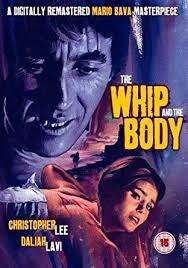
When Kurt Menliff is accused of seducing the daughter of a servant, Giorgia (Harriet Medin), who then commits suicide, his father, Count Vladimir Menliff (Gustavo De Nardoo), ostracizes him. Eventually Kurt returns to the family castle when he hears that his brother Christian Menliff (Tony Kendall) has just married Kurt’s old girlfriend Nevenka (Daliah Lavi). Kurt is looking to reclaim his title and inheritance.
Christian married Nevenka at his father’s urging despite the fact that he was really in love with his cousin Katia (Evelyn Stewart). One of the things Kurt wants to reclaim now that he is home is Nevenka. The relationship between the two of them runs deeper and darker than anyone knows or understands.
The next day Kurt finds Nevenka on the beach. After a session of whipping and sex Kurt leaves Nevenka on the beach and returns to the castle. Nevenka does not return. While everyone is out looking for Nevenka Kurt is killed with the same knife that Giorgia’s daughter Tania killed herself with. Nevenka is found with welts on her body and is brought back to the castle. One of the servants, Losat (Luciano Pigozzi), goes to find Kurt but finds his dead body instead. Kurt is buried in the family crypt.
At one point Kurt comes to Nevenka as a ghost and whips her. At the same time Count Menliff is being murdered in another room with the same knife that killed Kurt and Tania.
Nevenka, who at one time was betrothed to Kurt, and had sadomasochistic relationship with him, begins to come unhinged. She begins to hear whipping sounds in the castle. Then she sees him outside the window. Her masochistic love/hate obsession with Kurt convinces her that he is not dead and that he can never die. Whatever is happening to Nevenka is beginning to rub off on the other members of the household.
“The Whip and the Body” was released in 1963 and was directed by Mario Bava under the pseudonym John M. Old. It is an Italian Gothic Horror film. The film ended up banned by Italian censors because of its sadomasochistic themes. Apparently in your movie you can have desire or you can have torture but you can’t desire torture. The film was cut for both the U.S. and U.K. releases. It was finally released in the U.S. as “What” and in the U.K. as “Night is the Phantom”. Why such a big deal about a couple of whipping scenes? Because it was the sixties and even in Italy BDSM was not mainstream.
Besides the Sadomasochism, which these days would be considered tame, one of the things that make this film interesting is that the evil character that tortures the household, be it by whip or attitude, dies first.
Christopher Lee usually did all of his own dubbing for his foreign language films. This is one of the few European films he made where he did not dub his own voice because he was out of the country by that time. This is something he later regretted as he felt that his performance was one of his best as far as his foreign films were concerned.
The filmmakers wanted to make a picture that would fool Italian audiences into believing they were watching an American International Pictures Edgar Allan Poe style film or British Hammer film. To that end the cast and crew were told to use English pseudonyms for the credits. When producer Lucianto Martino went to Mario Bava he asked him to come up with “an old American name”. Martino meant it as a joke but Bava took him at his word and went with “John M. Old” and that is what is on the credits for director.
As far as making the film look like a Hammer production, they came pretty close. The indoor sets are lavish. The exterior shots are sweeping and full of that Bava cinematic touch that does resemble a Hammer-esque gothic nightmare. The only part that really says Italian horror is the dubbing. Something that is forgivable since the rest of the film is quite good.

